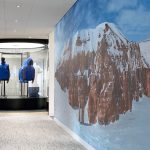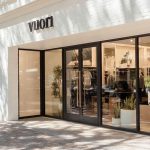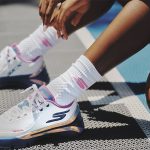Lululemon Athletica Inc. reported second-quarter earnings that came in ahead of internal expectations and slightly raised its outlook for the year. But shares still came under pressure as its third-quarter guidance came in sharply below Wall Street’s targets.
For the current quarter, Lululemon said it expects a profit between 35 and 37 cents per share, short of Wall Street’s consensus target of 43 cents. In the 2014 third quarter, it earned 42 cents a share.
For the year, the company, however, raised its EPS guidance to a range of $1.87 to $1.92 per share, a slight boost from prior profit guidance of $1.86 to $1.91. The higher full-year outlook reflected a slightly better-than-expected performance in the second quarter and expectations for a stronger fourth quarter.
In the second quarter, net earnings slipped 2.2 percent to $47.7 million, or 34 cents a share, exceeding its previous guidance calling for EPS in the range of 31 to 33 cents a share.
Revenues increased 15.9 percent to $453.0 million and 21 percent in constant currency. Total comparable sales, which includes comparable store sales and direct to consumer, jumped 11 percent on a currency-neutral basis. Previously, it had expected sales in the range of $440 million to $445 million and comps to rise in the high-single digits on a constant dollar basis.
Comparable store sales increased 6 percent and online revenue increased 35 percent on a currency-neutral basis. Comps across all regions were positive.
Direct to consumer net revenue increased 30 percent to $82.2 million, or 18.2 percent of total company revenue.
“Our women's business continues to build momentum with a particularly strong performance in pants and bras where both categories delivered double digit come for the quarter,” said Laurent Potdevin, CEO, on a conference call with analysts. “Our mens business was up 31 percent on a combined comp basis driven by our sweats category and Iviva also posted double digit comp growth with a 27 percent combined comp this quarter.”
Gross margins eroded 370 basis points to 46.8 percent in the quarter. The decline reflects 110 basis points of product margin decline, of which half was attributable to the cost variances primarily related to the West Cost port slowdown and the balance resulting from selling mix and raw material liabilities actions taken in the quarter. Thirty basis points was attributable to higher markdowns primarily due to the online warehouse sale held in the quarter, 50 basis points reflected deleverage due to higher air freight costs, and 70 basis points reflected deleverage due to the foreign exchange impact of a weaker Canadian and Australian dollar. Finally, 110 basis points came from deleverage from occupancy and depreciation related to its international expansion, renewals of existing stores, and higher lease costs associated with an increase in major renovations and relocations.
SG&A expenses were reduced to 32.1 percent of sales from 33.1 percent as net foreign exchange gains offset an SG&A dollar increase due to costs related to its international expansion, growth in e-commerce business and increased head office costs. Operating earnings declined 1.9 percent to 66.6 million.
Square footage growth increased 24 percent versus last year driven by the addition of 66 net new stores since Q214, including 39 in the U.S., three in Canada, one in Australia, three in Europe, three in Asia, and 17 Iviva stores.
Regarding its international expansion, LULU plans to open its first two stores in the Middle East in the second half. In Asia, new stores have exceeded initial plans with its first store in Hong Kong becoming the most productive store in the company on a per square foot basis. A second store is opening in Hong Kong in a larger format. Said Potdevin,” This early performance combined with our Singapore performance and the success of our storeroom in Seoul, validated or product for brand in Asia and leaves us confident with the development plan and its trajectory.”
In Europe, its first store in Hamburg, Germany opened in early September and a third London store is opening. Showrooms have opened in Germany, Netherlands, Sweden, Switzerland and France.
On the product front, Lululemon in the first week of September opened its first women’s pant wall.
“We have evolved the technical design of our women's pants to focus on Engineered Sensation,” said Potdevin. “Our innovation combines design, sports psychology, and training compression science to create a carefully considered spectrum of sensations allowing our guests to choose the right pant for her work out and unlock her performance potential.”
The Engineered Sensation spectrum features five categories: Relaxed, Naked, Held In, Hugged and Tight. Four new styles were launched with new construction and engineering, seamless technologies, and new fabrics that are lightweight and have a soft second skin feel. Said Potdevin, “While it's too early to analyze and quantify guest feedback, I am absolutely thrilled to see our educators and ambassadors respond to the product. They are and have always been the best indicator of future product success.”
Women’s bottoms “performed strongly” in the quarter and new tanks reached the store late in Q2. The mens growth was driven by strong sales in the sweat category, along with further improvements to its metals and franchise categories as it continues to introduce new fabrics such as inter thick and Primatech to support our male guest training pursuits. Added Potdevin, “That said, all mens categories including our no sweat and poor sweat offerings performed well and this result continued to validate our goal of building a billion dollar mens business globally.”
Other investments included its RFID rollout that is expected to be completed in the third quarter to enable seamless inventory management and labor savings. Its website is being redesigned to “aestheticly showcase our brand” with a planned relaunch in Q116. A near-term focus will be on optimizing traffic and conversion. On the marketing side, Lululemon successfully held its fourth annual marathon in Vancouver and hosted local events in communities in South Korea, Scotland and Germany.
Potdevin said investments in its product engine and supply chain “are creating solid foundation to support long term growth plans. The complexity of building a global scalable infrastructure while expanding product offering and geographic footprint has created near term pressure to gross margin.”
Inventories were up 55 percent at the quarter’s end, reflecting the fact that the company was significantly under inventoried for Q214 last year as well as the reaction to the port delays. Said Stuart Haselden, CFO, “The good news here is that our supply chain is normalized and we are now flowing inventory on schedule; however, our reported inventories will continue to look elevated as late product from the first half of the year now combines with on time flows and in some cases early flows for the second half.”
Expanding on its outlook, third-quarter revenues are expected to arrive in the range of $477 to $482 million. Comps on a currency-neutral basis are expected to increase in the high single digits.
Gross margins are expected to be approximately 47 percent. Many of the product margin pressures in Q2 are expected to continue to impact Q3, including some air freight.
For the full fiscal 2015, we now expect net revenue to be in the range of $2.025 billion to $2.055 billion based on total comparable sales in the high single digits on a constant dollar basis. Quarterly gross margin will be sequentially better in Q4 and benefit from improved air freight levels coupled with stabilized merchandise margins and less deleverage of fixed costs due to the high sales volumes generated during Q4.














